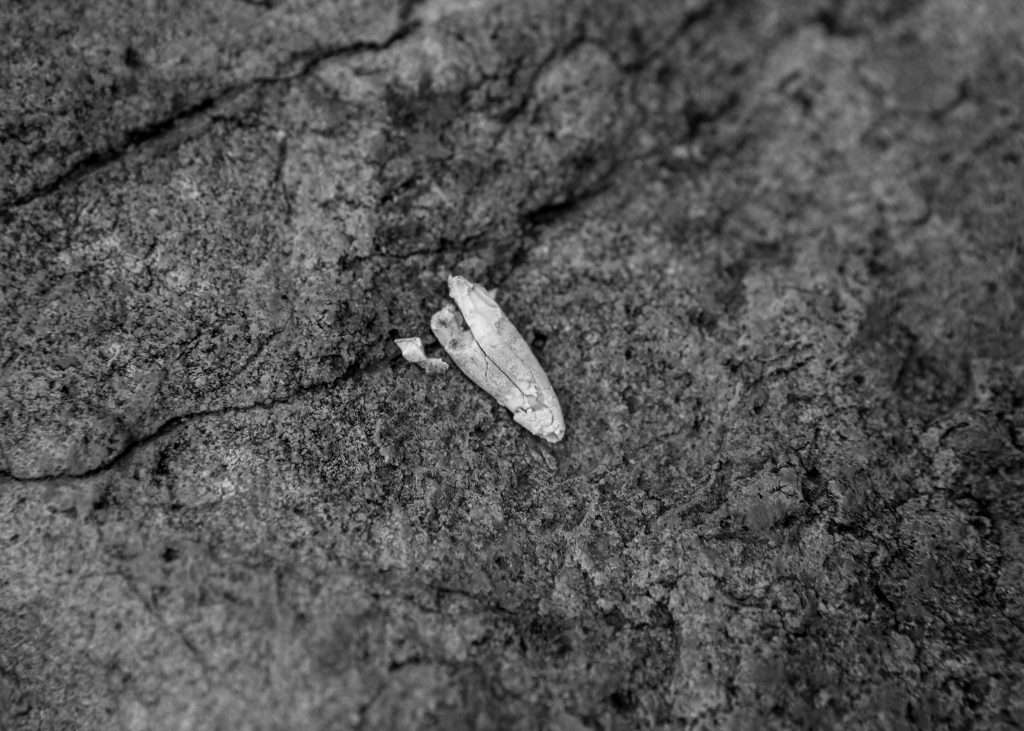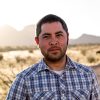Notes From a Crime Scene

Excerpted from The Land of Open Graves: Living and Dying on the Migrant Trail by Jason De León. University of California Press, 2015. All rights reserved.
Drive out in the late afternoon to one of the many hills on the outskirts of the tiny Arizona town of Arivaca and look west. You will see the golden sun creep behind the Baboquivari Mountains. The vanishing orb makes it look as if the distant peaks and valleys have been cut out of thick black construction paper. It’s the stenciled silhouette you see in old Western films. For an hour or so, the backlit barren landscape glows as though it’s slowly being covered in liquid amber. The beauty of this Sonoran Desert sunset is overwhelming. It can convince you that there is goodness in nature. It will make you briefly forget how cruel and unforgiving this terrain can be for those caught in it during the height of summer. Right now I’m dreaming about that sunset; visualizing my hand plunging into a watery ice chest full of cold beers. I can feel the touch of the evening breeze on my skin. These are the tricks you play in your head during the dog days of July in the desert.
The Norwegian explorer Carl Lumholtz once wrote that the summer heat in the Sonoran Desert felt like “walking between great fires.” That’s putting it nicely. Right now it feels more like walking directly through flames. Despite the protection of my wide-brimmed cowboy hat, the sides of my face are sunburned after only a few minutes of exposure. Tiny water-filled blisters are starting to form on my temples, cheeks, and other places that get exposed to the sun when I lift my head or stare up at the empty blue sky. I try not to look up unless I have to duck under a mesquite tree or the trail makes a hard break left or right. Better to keep your gaze downward to watch for sunbathing rattlesnakes and ankle-twisting cobbles.
Sweat beads up and rolls off my chin, leaving behind a trail of droplets on the ground as I walk. It takes only a few seconds for these splashes to evaporate. My clothes, on the other hand, are soaking wet. I find myself periodically shivering and getting dizzy; my body is working hard to make sense of this inferno. The overpriced backpack I am wearing has started to heat up along with the water bottles it contains. This means that from here on out, every time I try to quench my thirst, it’s like drinking soup. It is easily over 100 degrees and it is only 10 a.m. My sunset and cold-beer fantasies are starting to lose their efficacy. Photographer Mike Wells and I are climbing through the Tumacácori Mountains with my longtime friend Bob Kee, a member of the southern Arizona humanitarian group the Tucson Samaritans. Bob has been haunting these trails for years, leaving food and water for unseen migrants and occasionally giving first aid to abandoned souls he comes across.
It’s a rough path full of sharp-angled rocks and angry mesquites whose branches all seem to be aiming for your eyes. We are moving at a fast clip, which is typical for any outing led by Bob. He is almost 30 years our senior, but is running us ragged as we struggle to keep up. Mike and I are being led by a wilderness Zen master who never seems to sweat, complain, or slow down. Every turn he makes seems to lead to another steep climb. I am convinced he seeks out the most arduous routes just to make sure that those he takes into the desert get a sense of how punishing this environment can be for migrants and anyone else who dares to hike this terrain in the middle of a summer day.
People whose loved ones have disappeared in this desert will tell you that it’s the not knowing what happened to them coupled with the flashes of grotesque possibility that drive you insane.
“We’re almost there. I promise,” Bob says. I force a smile because in the past when he has told me this, it was a white lie to make me feel better. “Almost there” is one of Bob’s euphemisms for “four more miles to go.” On this day, however, the tone in his voice is different. He is not his normal jovial self. He hasn’t been joking around, which usually includes offering to carry me on his back. It is clear that he is on a mission. We round a bend and stop. Bob calmly says: “This is the spot where I found the person. The sheriff’s department came out and took away what we could find, but it was getting dark and we didn’t have a lot of time to go over the entire area. It was mostly arm and leg bones and some pieces of clothing. I want to see if we can find the head. That would make it easier to identify the body. I’m sure there are still bones out here.”
Just a few weeks earlier Bob had encountered the fragmented and skeletonized remains of a border crosser in this area. It was the second person he had found in under a month. He called the police, who sent two detectives out to remove what bones they could find. Bob says they spent five minutes poking around before they called it quits. It was too damn hot and the cops were unprepared and unmotivated to do a large-scale survey. Besides, searching for the bones of dead “illegals” has never been a top priority for any law enforcement agency out here. The three of us have returned and are now looking for the rest of what was once a living, breathing person.
Bob is right. There are bones that the detectives overlooked, but we have to cover a lot of ground before we find any of them. There are pieces strewn everywhere. We walk downslope and see part of an articulated arm wedged between two rocks. Aside from sinew still holding the bones together, it has been picked clean of skin and muscle by an unknown creature. Further up the trail I notice several white flecks that stand out against the red mountain soil. It looks as if someone dropped a box of blackboard chalk on the ground. I get closer and realize they are splinters of human bone, mostly sun-bleached rib fragments that have been cracked and gnawed by some long-gone animal. Just off the trail I spot a complete tooth lying on top of a rock. This dental find gives us hope that the skull is nearby.
We start a desperate search for this person’s head. Rocks are overturned. Subterranean nests are probed. Bleeding hands blindly grope under thick brush in hopes of finding bones that may have been squirreled away by scavengers or deposited by monsoon flood waters. Everyone is moving with great urgency despite the debilitating heat. After 45 minutes of intensive survey, we give up. There is no skull. There are no other teeth. We do, however, come across a pair of worn-out hiking boots in close proximity to some of the bones. Where the hell is the skull? I start imagining what has happened to it. A montage of laughing vultures rips this person’s eyeballs out of the sockets. I hallucinate two coyotes batting the head around like a soccer ball so that they can access brain matter through the foramen magnum. It’s a moment when you despise the capacity of the human imagination. People whose loved ones have disappeared in this desert will tell you that it’s the not knowing what happened to them coupled with the flashes of grotesque possibility that drive you insane.
Mike starts snapping photographs while Bob collects bones. The gnarled arm fragment goes into a black trash bag. The ribs and tooth fall into a Ziploc. Bob scribbles down the GPS coordinates and will later deliver the remains to the sheriff’s office, where he will be scolded for “disturbing a crime scene.” The irony of the statement is that the police were already out here once and Bob is simply collecting what they overlooked during their hasty survey. The fact of the matter is that although this is a crime scene, few people actually care or want to know what has happened here. For many Americans, this person—whose remains are so ravaged that his or her sex is unknown—is (was) an “illegal,” a noncitizen who broke U.S. law and faced the consequences. Many of these same people tell themselves that if they can keep calling them “illegals,” they can avoid speaking their names or imagining their faces. The United States might be a nation founded by immigrants, but that was a long time ago. Countless citizens today suffer historical amnesia and draw stark divisions between the “noble” European immigrants of the past and Latino border crossers of today. How quickly they forget about the violent welcome receptions that America threw for the Irish, Chinese, and many other newly arrived immigrant groups. The benefit of the chronological distance from the pain and suffering of past migrations is that many Americans today have no problem putting nationality before humanity. A cursory glance at the online comment section of a recent article titled “Border Crossing Deaths More Common as Illegal Immigration Declines” provides insight into some of the more extreme anti-immigrant perspectives on migrant death:
I’m not condoning deaths or anything, and I do think it’s cruel to let a human being die in pain, but in a way isn’t it better? I mean after all some of these people are risking their lives because there are nothing better [sic] back home, and if they die on the way, at least they end their sufferings [sic].
Since it is a common practice to print indications on everything in the US, and since just printed indications will not . . . [deter] people from entering the US illegaly [sic], why not . . . take some of those dried out corpses, hang them at the places where they [migrants] are known to cross with a legend, “This may be you in a couple of days.” (All reader comments were subsequently removed by The Huffington Post sometime in 2015.)
When you see such comments, which accompany practically every article about migrant death on the Internet, you think you’re mistakenly reading the American Voices column from the satirical newspaper The Onion. It should be easy to dismiss responses like these as extreme forms of Internet hate speech, but this disregard for the lives of undocumented people and the idea that dead bodies should act as a form of deterrence to future migrants are fundamental components of the U.S. federal government’s current border security strategy. But that fact doesn’t really matter as we survey the ground for more human remains. The desert has already started to erase this person, along with whatever violence and horror she or he experienced. This event will soon be forgotten before it was ever known.
































